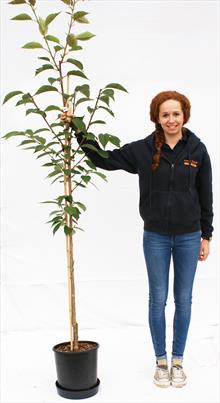Tai-haku
Prunus serrulataTaihaku or Tai-Haku, is a traditional white-flowered Japanese flowering cherry.
It is notable for its very large single white flowers, probably the largest of any flowering cherry. It is sometimes known as the "Great White Cherry" for this reason.
As well as the stunning spring blossom display, Tai-Haku also has attractive dark bark, and the leaves turn yellow-orange in autumn.
Tai-haku is quite similar to another white-flowered cherry - Shirotae - and they are both forms of the Japanese mountain cherry Prunus serrulata. However Tai-haku has larger single flowers while the flowers of Shirotae are not quite as large, but are often semi-double. Shirotae invariably grows with a strongly spreading habit and horizontal branches while Tai-haku is initially more upright and spreading, although it can become spreading in the longer term. The emerging leaves of Tai-haku invariably have a distinct copper-orange tint, before turning green as they mature.
Tai-haku japanese flowering cherry trees for sale

All our pot-grown trees are grown for us to our specification by the Frank P Matthews nursery.
All pot-grown trees are suitable for planting out in the garden, some are suitable for growing in containers.
11-year bare-root
tree
£46.50
Large size (3m-5m after 10 years)
Out of stock
Sorry we have sold out for this season
22-year pot-grown
tree
£71.95
Grown for us by Frank P Matthews nursery
In a 12L pot
Large size (3m-5m after 10 years)
Next deliveries
Order now for delivery from 24th April.
How to grow
Tai-Haku is a versatile tree for the larger garden, it grows rapidly into a medium-large tree with a strongly spreading habit.
Do not be put off by its reputation for getting larger and larger - we graft the tree on to a cherry rootstock which will keep the mature height down to around 4m-5m, while retaining its elegant proportions.
History
Tai-haku is a form of Prunus serrulata, which is the traditional Japanese garden cherry ("sato-zakura"). Surprisingly it died out in its native country, but in the 1930s the English flowering cherry enthusiast Major Colllingwood Ingram discovered a tree growing in a garden south of London, and identified it from an 18th century Japanese painting. This remarkable piece of botanical detective work cemented Collingwood Ingram's place as the foremost expert of his generation, in both the west and in Japan. All modern examples of this important variety are descended from the English tree.
Tai-haku characteristics
- Gardening skillBeginner
- AwardsRHS AGM (current) - 1993RHS AM - 1931
- Attractive featuresAttractive flowersAttractive barkScented flowers
- Growth habitSpreading / Flat-toppedUpright-spreading / Vase
- Height after 10 years3m-5m / 10ft-16ft
- Growth rateFast
- Site conditionsOccasional flooding
- Flower colourWhite
- Flower formSingle flower (5-8 petals)
- Flowering monthApril
- Leaf colourGreen
- Leaf colour - autumnOrange / Gold
- Leaf/Flower sequenceLeaves appear first
- Country of originJapan
- Annual cycleDeciduous
Similar varieties
PrunusShirotaePrunus Shirotae features large single or semi-double fragrant white flowers, and is perhaps the most beautiful of the white-flowered Japanese cherries.
What will it look like?
Illustrative example of a pot-grown tree of this variety as supplied.
Approximate girth: 6/8cm. We try to keep all pot-grown trees down to about 1.5m as supplied, but some may be larger.
Trees should reach their mature height after about 10 or more years.
We may also have 1-year bare-root trees of this variety - they are not shown here.

How to choose a flowering cherry tree
We list more than 70 different flowering cherry trees. Choosing can be difficult! Our article explaining the different characteristics of flowering cherries might help narrow down the selection.
 Over 400 varieties of flowering cherries, crab apples, rowans and other ornamental trees.
Over 400 varieties of flowering cherries, crab apples, rowans and other ornamental trees.